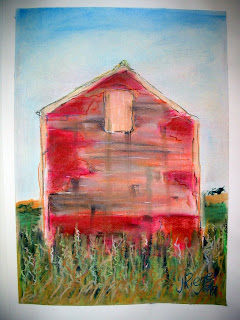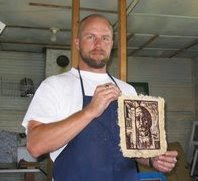I have always been interested in the sketches of the masters- da Vinci, Michelangelo, it didn't matter; I found the raw idea very interesting, perhaps even more interesting than their finished paintings. A sketch carries a sense of freshness, an urgency or a moment in time unencumbered by refinement and rethinking. In many ways there is a purity in a sketch that is difficult to express in a finished painting. I beleive that same freshness is much the same feeling the German expressionists like those in the Blaue Reiter and Die Brücke tried to present in their work. Naturally context for painting has changed from Europe between the wars as has the subject matter but the essence- human emotion, response, and discourse has not.
In my work I try to reverse the painting process, so to speak. You see, it is my understanding that paintings usually begin on a piece of scratch paper, on a napkin, or in a sketchbook somewhere. Then it is refined, edited, paired down to simplest terms, and put onto canvas in paint or collage or whatever. I do this too, but in my work the painting usually begins with the idea written into my sketchbook and several sketches added of how the idea may be represented visually or metaphorically. Following this I collect additional material like newspaper articles or research on the subject to flesh the idea out a bit more. Then I set up some problems to be solved on the canvas like the devision of space, relationship of the elements, ect. by painting a few of them on the canvas then adding or reducing as need be. Lastly I try to add once again the sketch right out of my sketchbook onto the top "layer" of my painting. An example of this may be "Repetitive Pump in Purple". In a way I want to invert a painting so others can see the process the idea goes through in the work. I hope this last sketch carries the freshness or urgency of the original idea in some way.
In my work I try to reverse the painting process, so to speak. You see, it is my understanding that paintings usually begin on a piece of scratch paper, on a napkin, or in a sketchbook somewhere. Then it is refined, edited, paired down to simplest terms, and put onto canvas in paint or collage or whatever. I do this too, but in my work the painting usually begins with the idea written into my sketchbook and several sketches added of how the idea may be represented visually or metaphorically. Following this I collect additional material like newspaper articles or research on the subject to flesh the idea out a bit more. Then I set up some problems to be solved on the canvas like the devision of space, relationship of the elements, ect. by painting a few of them on the canvas then adding or reducing as need be. Lastly I try to add once again the sketch right out of my sketchbook onto the top "layer" of my painting. An example of this may be "Repetitive Pump in Purple". In a way I want to invert a painting so others can see the process the idea goes through in the work. I hope this last sketch carries the freshness or urgency of the original idea in some way.












